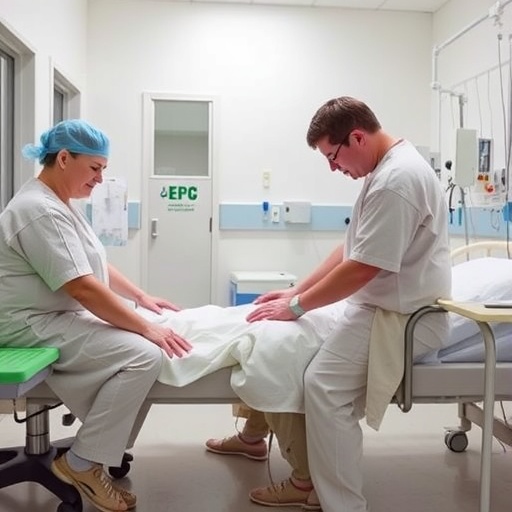In recent years, the management of patient behaviors in healthcare settings has garnered increasing scrutiny and attention. Among the various strategies employed, the use of restraints—both physical and chemical—has been a particularly contentious topic, especially in inpatient medical, surgical, and psychiatric units. The intricate dynamics of employing restraints have significant implications not only for patient outcomes but also for the ethical practices of healthcare providers. The recent study by Hing, Fraden, and Yablon dives deep into understanding the characteristics of restraint use within these critical environments, shedding light on a practice often shrouded in controversy.
Restraint use in hospitals can be viewed through multiple lenses, including clinical necessity, ethical considerations, and regulatory guidelines. The diverse nature of inpatient units means that the rationale for utilizing restraints can differ dramatically depending on the clinical context. For instance, the acute psychiatric unit may frequently face episodes of intense agitation and risk, necessitating immediate protective measures. Conversely, in a surgical ward, restraints may be employed to prevent patients from inadvertently harming themselves post-operation, highlighting the need for a nuanced understanding of context-specific applications.
One of the pivotal concerns surrounding restraint use is the potential for adverse outcomes, both psychologically and physically. Patients subjected to restraints can experience feelings of humiliation, powerlessness, and anxiety, further exacerbating their underlying conditions. The research conducted by Hing and colleagues emphasizes the necessity of monitoring these psychological consequences alongside the physical safety that restraints are intended to provide. This dual focus invites healthcare professionals to engage in a broader dialogue about alternatives to restraint, exploring non-coercive strategies that empower patients rather than diminishing their autonomy.
The methodology of this research underscores its robustness and rigor. By focusing on a tertiary care county hospital, the study captures a diverse patient population, one that is likely to reflect a broader spectrum of behaviors and clinical needs. The researchers utilized a combination of observational data and retrospective chart reviews, allowing them to aggregate quantitative and qualitative insights into the practice of restraint. This methodological triangulation enhances the credibility of their findings, offering a lens through which to examine normalizations of restraint use and the patterns that emerge in specific clinical contexts.
A critical aspect of the study is the contrast it draws between the use of restraints in medical/surgical units versus psychiatric units. The researchers uncovered distinct patterns characterized by different motivations and outcomes associated with restraint use in each setting. While psychiatric wards may prioritize immediate behavioral stabilization, surgical units often focus on post-procedural safety. These differences raise essential questions regarding training and protocols tailored to each environment, suggesting that a one-size-fits-all approach to restraint policy may be insufficient.
Moreover, the research findings highlight the impact of staffing levels on restraint practices. Facilities with higher ratios of trained nursing staff may demonstrate reduced reliance on restraints, emphasizing the role that adequately supported healthcare teams play in fostering environments that prioritize patient dignity and safety. This finding serves as a clarion call for healthcare institutions to invest in robust staffing models that promote comprehensive care and proactive behavioral management strategies.
The implications of this study extend beyond immediate clinical practice. They may also inform broader healthcare policies related to patient rights and institutional accountability. With increasing attention from regulatory bodies on the ethical practice of restraint use, hospitals must not only comply with existing mandates but also engage in continual quality improvement initiatives that reflect best practices in patient care. This proactive approach can help mitigate the risks associated with restraint use while promoting patient-centered care models.
In addition to advocating for evidence-based policies, the study sparks a necessary conversation about the training and education of healthcare providers. An informed staff equipped with the skills and knowledge to manage challenging behaviors without resorting to restraints can result in improved patient experiences and outcomes. Comprehensive training programs that include modules on de-escalation techniques, communication skills, and conflict resolution could ultimately reshape how healthcare workers perceive and react to crises, leading to a decrease in the incidence of restraint use.
Through this lens, the impact of the study emerges as not only a reflection of current practices but as an impetus for change. By highlighting the complex realities of restraint use across patient populations, the researchers have provided healthcare leaders with critical insights that can guide the development of institutional policies aimed at reducing reliance on restraints. This holistic focus on patient experience, safety, and clinical necessity is pivotal to fostering environments that are both compassionate and effective.
As healthcare continues to evolve, the insights gathered from this research underpin the importance of patient advocacy and safety. Understanding and addressing the multifaceted reasons behind restraint use can help professionals create a more supportive climate conducive to healing, irrespective of the clinical context. By continuing to examine these characteristics, future studies can pave the way for innovative approaches that prioritize patient dignity while addressing clinical needs effectively.
In conclusion, Hing et al.’s investigation into the characteristics of restraint use in inpatient medical, surgical, and psychiatric units provides a vital contribution to the ongoing discourse surrounding patient care. Through their evidence-based examination of restraint practices, they illuminate the ethical considerations that must underpin institutional approaches to behavioral management. A commitment to safeguarding patient rights while ensuring safety might ultimately redefine the standards of care practiced within healthcare institutions.
Understanding the dynamics of restraint use is essential for healthcare providers seeking to align their practices with the principles of patient-centered care. As conversations around mental health, ethical treatment, and patient autonomy grow, the findings from this study will undoubtedly reverberate throughout the medical community, fostering ongoing discussions about how best to support individuals in need. This study highlights that minimizing restraint use is not simply about reduced numbers; it’s about reshaping care culture towards one characterized by respect, dignity, and comprehensive support for all patients.
Subject of Research: Restraint use in inpatient medical/surgical and psychiatric units
Article Title: Characteristics of Restraint Use on Inpatient Medical/Surgical and Psychiatric Units at a Tertiary Care County Hospital.
Article References:
Hing, A.K., Fraden, M., Yablon, B. et al. Characteristics of Restraint Use on Inpatient Medical/Surgical and Psychiatric Units at a Tertiary Care County Hospital. J GEN INTERN MED (2025). https://doi.org/10.1007/s11606-025-09884-x
Image Credits: AI Generated
DOI: 10.1007/s11606-025-09884-x
Keywords: restraint use, inpatient care, patient safety, ethical treatment, mental health, healthcare policy, clinical practices
Tags: adverse effects of restraints on patientscontext-specific restraint applicationsethical considerations in restraintshealthcare provider ethics in restraint useimplications of restraint useinpatient medical unitspatient behavior management strategiespatient outcomes and restraintsphysical and chemical restraintspsychiatric unit restraint useregulatory guidelines for restraintsrestraint practices in healthcare





